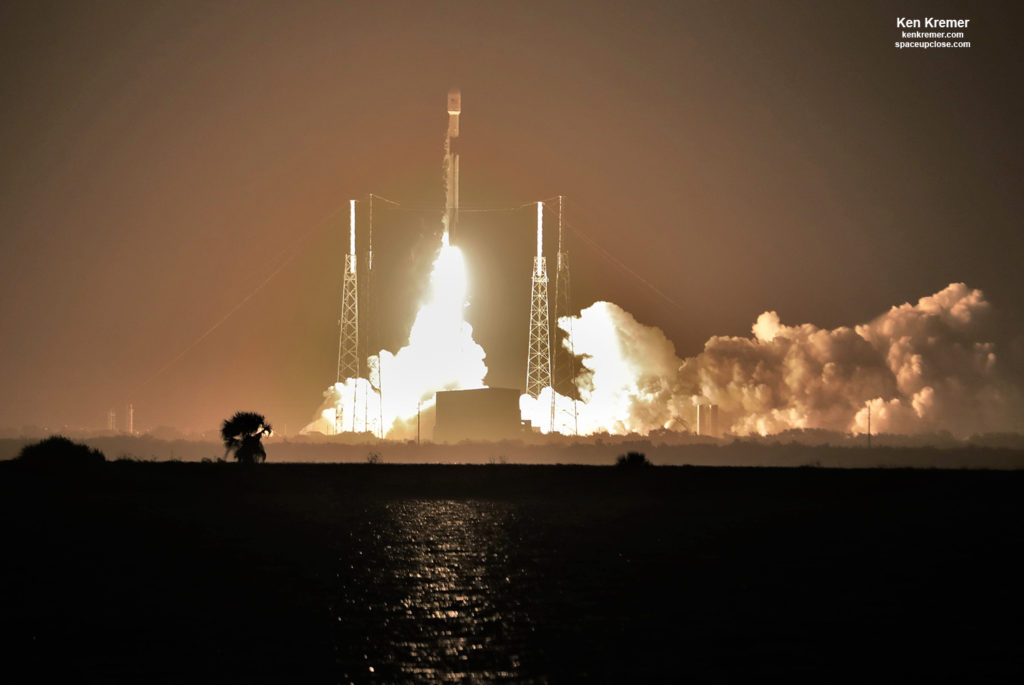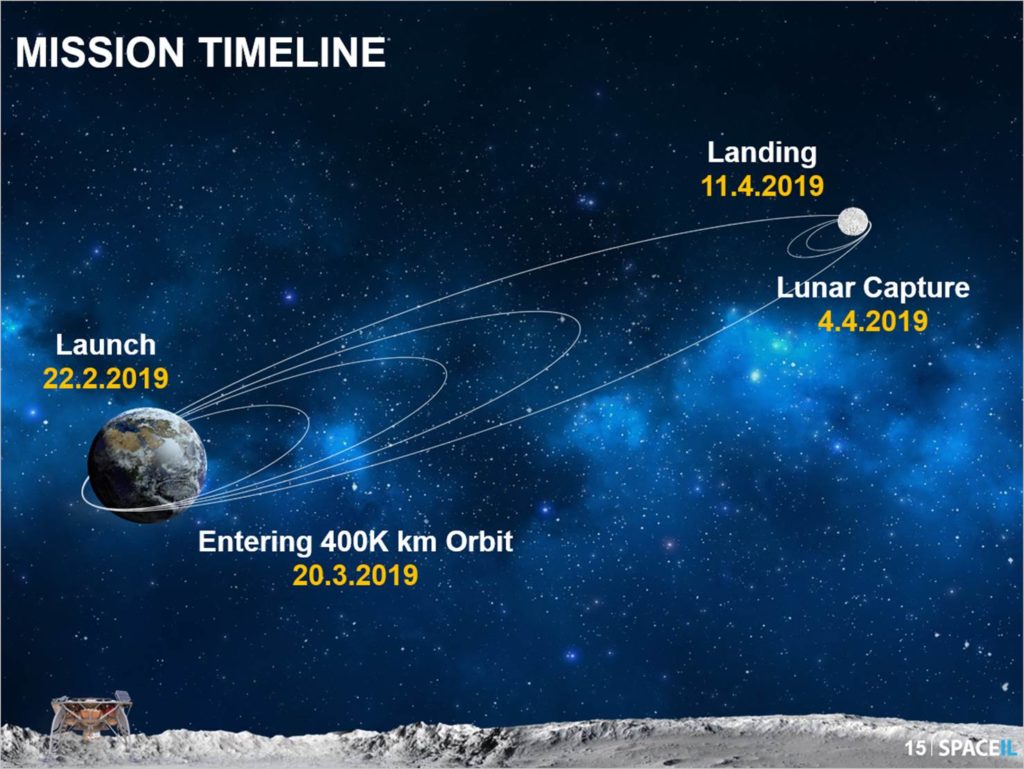 |
|
Israeli Beresheet moon lander
mission timeline and trajectory. Lunar orbit capture planned for April 4, 2019. Credit: SpaceIL/IAI |
NEW YORK – Its do
or die with a critical thruster firing upcoming on Thursday, April 4, for Israel’sBeresheet lunar lander required so the Moon can capture the tiny probe and set
the stage for a hoped for a history making soft landing 1 week later on April 11.
The thruster maneuver is planned to take place tomorrow April 4, at 5:15
p.m. Israel time or 10:15 a.m. ET, 1415 GMT, as all space enthusiast eyes are looking to
Earth’s nearest neighbor and the worlds first commercial lunar touchdown effort.
In fact it is the mpst critical of all the firings to date following a
quartet of orbit raising maneuvers that placed Beresheet on target for lunar
capture.
“Lunar Capture maneuver will determine if an Israeli spacecraft orbits
the moon,” says the mission team led by
SpaceIL and Israel
Aerospace Industries (IAI).
The six minute long thruster
braking firing of the crafts main engine will slow the craft for capture into lunar
orbit braking and reduce Beresheet’s velocity relative to the moon from by about 1000 km/h (600 mph) 8,500
km/h (5,281 mph) to 7,500 km/h (4,660 mph).
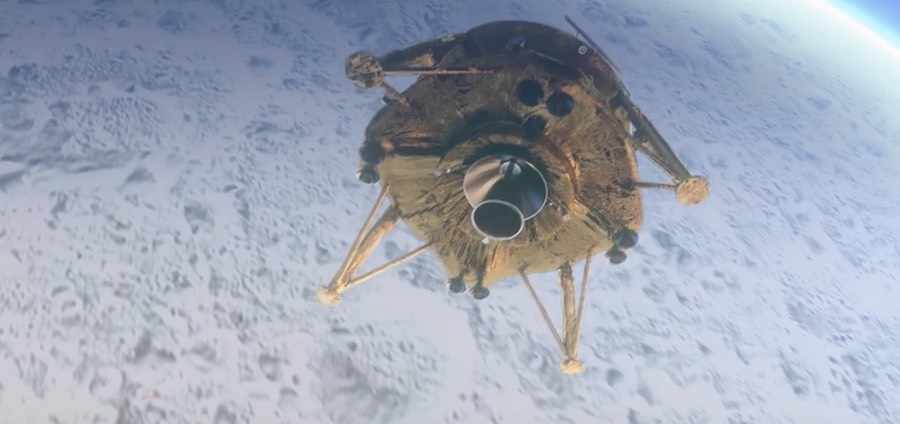 |
|
Artists concept of Israeli Beresheet lunar probe firing thrusters
for moon landing slated for April 11, 2019. Credit: SpaceIL/IAI |
If the “Lunar Capture” maneuver fails, Beresheet will not enter orbit around
the Moon and the mission will end tomorrow.
The Beresheet lunar lander is a joint endeavor
funded and built by Israeli nonprofit SpaceIL and Israel Aerospace Industries
(IAI). It marks Israel’s first lunar mission and also counts as being the
world’s first privately funded lunar mission.
If
all goes well lunar touchdown is scheduled for April 11 at Mare Serenitatis (Sea of Serenity) on the Moon’s
northern hemisphere on the upper right side as seen from Earth.
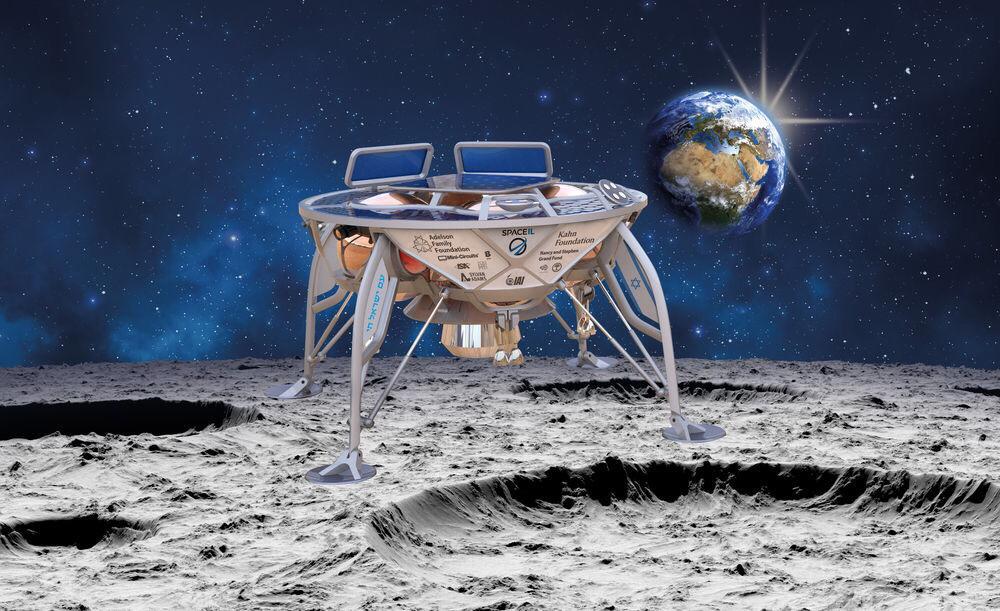 |
|
Artists concept of Israeli Beresheet lunar lander mission
with sponsors. Credit: SpaceIL/IAI |
“If the slowdown does
not take place as planned, the spacecraft risks leaving Earth’s gravity while
missing the moon’s gravity and will enter a different and undesirable orbit in
the solar system. This would bring the mission to an end,” says the team in a statement
released April 3.
If all goes well the
braking maneuver with insert the probe into an elliptical orbit around the
moon, in which the low point (perilune) is 500 km (310 miles) away from the
moon, while the farthest point (apolune) is 10,000 km (6,213 miles) away.”
The team will command
Bereshett to conduct several additional firing over the next week to lower and
circularize the orbit to a round orbit
200 km (124 miles) above the moon.
“Unlike the long Earth
orbits, the first lunar orbits will last 14 hours. As Beresheet approaches
landing, each moon orbit will last only two hours. These maneuvers are meant to
lower the spacecraft’s altitude and reach the optimal point for autonomous
landing in the moon’s Sea of Serenity the evening of April 11, says the team.
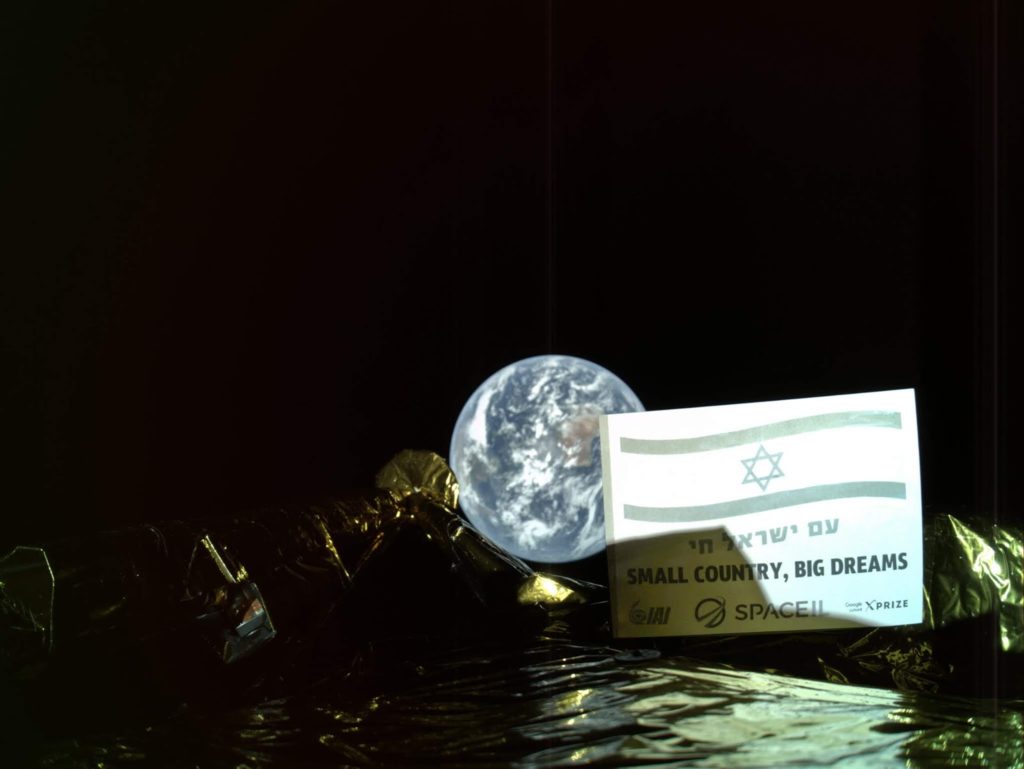 |
|
Selfie snapped by Beresheet spacecrafts on
board camera shows the lander, Earth and Israeli flag at a distance of 23,000 miles (37,000 kilometers). Credit: SpaceIL/IAI |
To date Beresheet has performed seven thruster firings and traveled over
5.5 million km ( 3.4 million mi.) in its long looping orbits around Earth edging
closer to the Moon and has another million to go before the landing.
During its voyage to date it orbited Earth 12.5 times on ever expanding long
looping traverses: seven at an altitude of 70,000 km (nearly 44,000 miles), two at an
altitude of 131,000 km (nearly 814,000 miles), two at an altitude of 265,000 km
(nearly 165,000 miles) and 1.5 at 420,000 km (over 260,000 miles).
Liftoff
of the private
Beresheet moon lander for Israel atop a recycled SpaceX Falcon 9 rocket took place in the
evening of Feb.
21 at 8:45 p.m. EST (0145 GMT Friday) from Space
Launch Complex-40 on Cape Canaveral Air Force Station, FL.
It flew as a rideshare
payload bolted to the primary payload – namely the Nusantara Satu communications
satellite for Indonesia.
Watch my launch video here:
lander and Indonesian Nusantara Satu comsat roars to life Feb. 21, 2019, 8:45 p.m. ET from Space Launch Complex-40
on Cape Canaveral Air Force Station, Florida – as seen in this video camera stationed at pad. Credit: Ken
Kremer/kenkremer.com/spaceupclose.com
To date only three countries have successfully
landed on the Moon- the US, Russia and China and those were all government run
missions.
Beresheet was developed at a cost of almost $100
million as the world’s first privately funded and developed moon lander.
Hebrew means “genesis” or “in the beginning” was one of the competitors for the
now defunct Google Lunar XPrize.
The Falcon 9 launch propelled Beresheet onto the proper
trajectory to begin a series of 4 elongating long looping orbits to gradually
reach the moon.
The four landing legs were deployed as planned soon after
launch.
If successful it will
be the smallest spacecraft to ever land on the Moon, at only 1,322 lbs, or 600
kgs, fueled. The probe has an unfueled mass of 180 kg.
Beresheet is traveling to the
Moon using its own power and thruster after launching as a rideshare
payload.
Overall the voyage takes
about two months over several expanding
elliptical orbits – for the longest ever trip to Earth’s nearest neighbor covering a total distance of 6.5 million km.
It will transmit panoramic
photos and video from the lunar surface and conduct scientific measurements
with a magnetometer and laser retroreflector from NASA. Also onboard is an Israeli flag, a time capsule, and a lunar library.
Beresheet has a lifetime of about 2 days. There
is no thermal control. The team hopes to make it hop about 500 meters before it
dies.
The moon probe measures 2.3 meters (7.5 ft) in
diameter and 1.5 meters (4.9 feet) in height.
Watch my post thruster maneuver interview on i24 Isreali TV News
on March 19 here:
the Israeli lunar lander spacecraft #Beresheet
upcoming soon on April 4, here’s
my full interview on i24 TV News live with Anchor Michelle Makori on March 19, 2019 discussing the
status of Beresheet’s last major thruster firing + landing prospects Apr 11.
And potential US space cooperation with Brazil as a rocket launch base.
Beresheet landing is slated for April 11. It launched on a #SpaceX #Falcon9 rocket on 21 Feb. 2019 from Cape
Canaveral Air Force Station, FL.
interview on i24 Isreali TV News here:
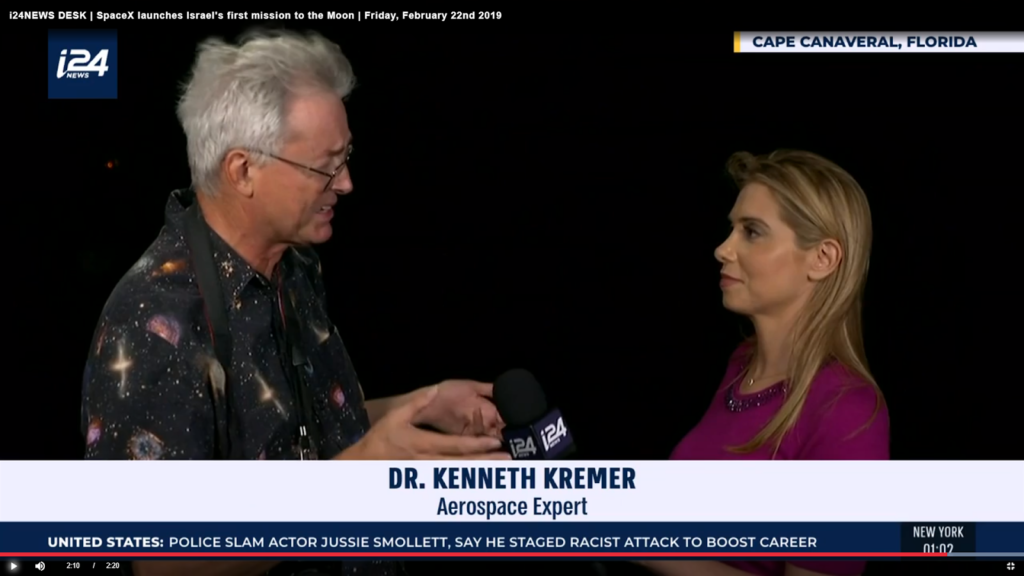 |
|
Dr. Ken Kremer/Space UpClose interviewed by I24
anchor Michelle Makori during Beresheet mission launch on SpaceX Falcon 9 from Cape Canaveral Air Force Station Feb 21, 2019 |
For more on all this
Fox 35 Orlando interviewed me about the Nusantara Satu/Beresheet moon lander launch and Mr. Steven’s arrival and fairing recovery
goals.
launched Beresheet and then safely touched down on the OCISLY droneship at sea
arrived into Port Canaveral by tugboat Sunday morning, Feb 24, just 2.5 days
after blastoff. Read my story photos
here.
Watch for Ken’s
continuing onsite coverage of NASA, SpaceX, ULA, Boeing, Lockheed Martin,
Northrop Grumman and more space and mission reports direct from the Kennedy Space
Center, Cape Canaveral Air Force Station, Florida and Wallops Flight Facility,
Virginia.
Stay tuned here for Ken’s continuing Earth and
Planetary science and human spaceflight news: www.kenkremer.com –www.spaceupclose.com – twitter @ken_kremer
– email: ken at kenkremer.com
Dr. Kremer is a research scientist and journalist based in the
KSC area, active in outreach and interviewed regularly on TV and radio about
space topics.
Ken’s photos are for sale and he is available for lectures and outreach events
Ken’s
upcoming talks:
“Exploring Mars; The Search for Life & A Journey in 3-D.” 7 PM, Lawton C
Johnson Middle School, Summit, NJ:
https://www.eventbrite.com/e/sef-grant-presents-exploring-mars-and-the-search-for-life-3d-registration-55524445110


